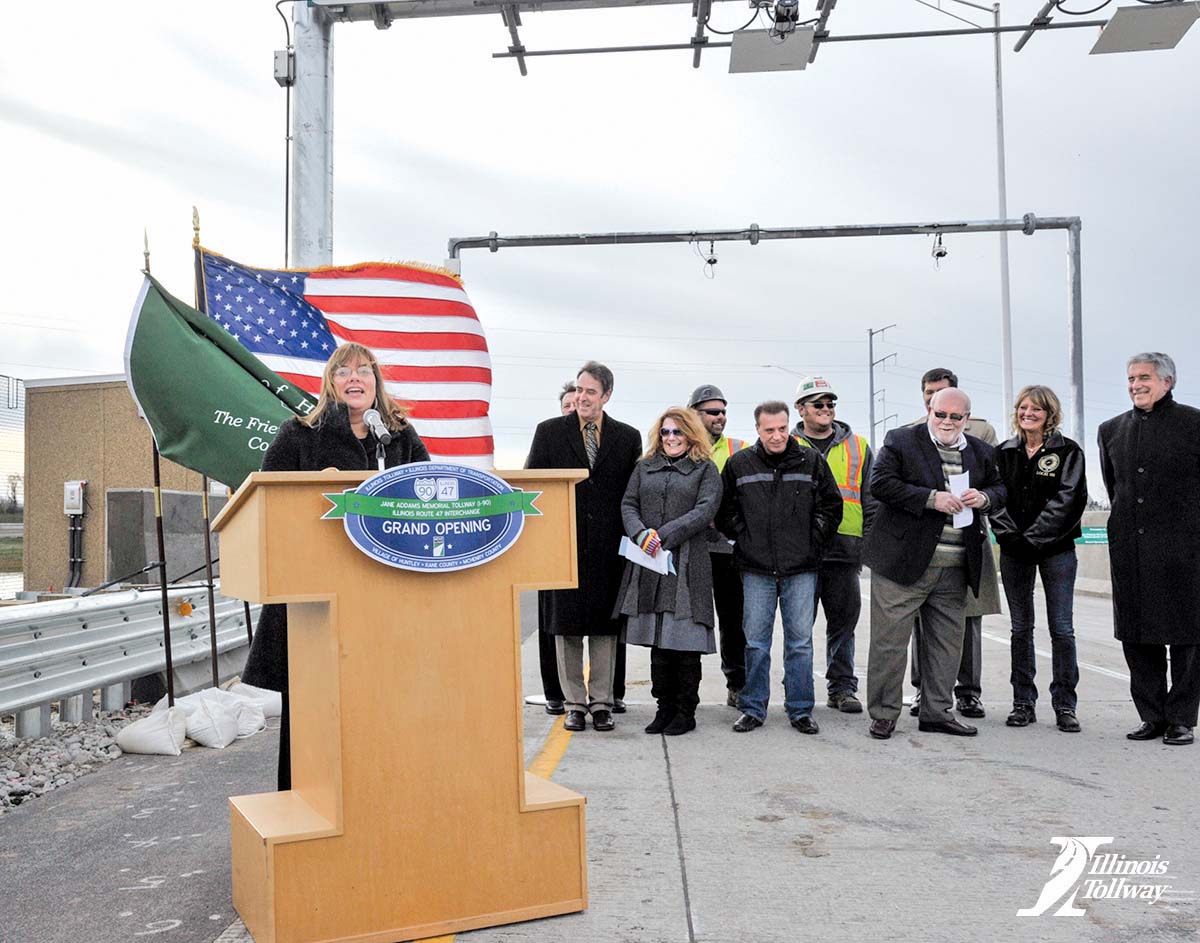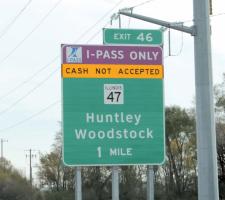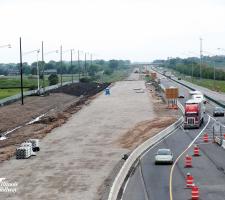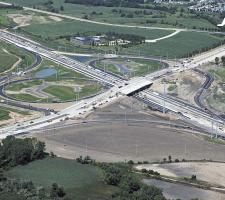
Illinois Tollway executive director Kristi Lafleur speaks at the grand opening of the Huntley interchange
David Crawford welcomes the adoption of European-style ITS technology by the US.
The Jane Addams Memorial Tollway in Illinois, US is well on the way towards becoming a ‘Smart traffic corridor’, taking full advantage of active traffic management (ATM or ‘managed lanes’) technology that originated in Europe. It is one of the First American Toll roads to do so; preliminary work began in 2014 and will continue through to 2016. Jane Addams is one of four Toll roads operated by the publicly-owned Illinois State Toll Highway Authority (7775 Illinois Tollway). It forms part of the officially designated US Interstate 90 (I-90) a 99km route extending eastwards from Rockford, near the Wisconsin state line, to the outskirts of Chicago.
In the First phase, reconstruction and widening of a 26km-long eastern segment will add a fourth lane to the existing three in either direction, with a 5.33m-wide inner ‘preferential’ shoulder. This is intended for the use of buses run by Chicago suburban operator Pace and emergency vehicles and when necessary (for instance to avoid a disabled vehicle), general traffic. The phase will also see full-scale ATM implementation on the segment leading into the city of Chicago.
The US$2.5bn I-90 Rebuilding and Widening Project forms part of the Illinois Tollway’s US$12bn Move Illinois: The Illinois Tollway Driving the Future programme. The upgraded route is expected to save drivers up to 27 minutes on an average trip on the eastern segment between the Elgin Toll plaza and the Kennedy Expressway, which runs northwest from the Chicago central business district to the city’s O’Hare Airport. The western segment will increase from two to three lanes in either direction.
The ATM technology is being installed at the construction stage to avoid later costs.
Says Illinois Tollway executive director Kristi Lafleur: “We live in one of the most congested regions in the country and we can’t keep building a lane every time congestion increases. Information will be critical to drivers making smarter choices.”
The completed project will accommodate some 30,000 additional vehicles daily along the eastern segment and over the whole 99km stretch it will be able to handle an additional 83,000 vehicles daily including 15,000 trucks carrying 375,000 tonnes of freight. Overall the scheme is expected to save drivers US$440 million per year in reduced congestion and fewer delays resulting from both physical and informational upgrades.
Overhead gantries at relatively short intervals will allow the ATM system to give drivers real-time information on the nature and status of upcoming traffic incidents and congestion, lane closures and changes, posted alternative routes and traffic patterns as well as advisory speeds. Existing monochrome digital dynamic message signs are giving way to higher-resolution, full-colour, graphics-capable displays.
Roadway cameras are being upgraded from analogue to high-definition digital and installed in greater numbers to cover the full length of the corridor. Weather stations are being reengineered for the more accurate detection of adverse conditions at critical locations such as bridges.
Traffic control centre (TCC) staff will monitor the road 24/7 use the system to monitor and regulate the use of the shoulder lanes. In the event of an incident, the will be able to reduce the advisory speed limits to give drivers more time to slow down to avoid worsening congestion.
But existing traffic regulations, including Illinois’ ‘Move Over’ law requiring drivers to change lanes for emergency vehicles, will remain enforceable.
The rebuild already incorporates the most recent of Illinois Tollway’s planned series of all-electronic interchanges including the junction with Illinois State Route 47 at Huntley. This was completed in November 2013 with electronic fee collection (EFC) equipment on four access ramp gantries. Huntley is a fast-growing outer suburb of Chicago, with an industry-based economy reflecting its location along the I-90 and Route 47 high-traffic truck corridors.
Developed to unblock regional travel movement, the resulting interchange is the result of a pioneering cost-sharing agreement in which the agency provided 50% of the funding, the Illinois Department of Transportation 25% with local communities contributing the final 25%. The new Huntley interchange is also the First ‘green’ one on the agency’s network (see below).
Vehicles not carrying the Illinois Tollway’s I-Pass transponders have their details recorded by automatic numberplate recognition (ANPR) and drivers are given seven days to pay online or by post. The transponders are interoperable with the E-ZPass Toll payment system covering 14 other American states.
The agency has offered EFC since 1993 and open-road tolling across its 458km network since 2006. New toll roads being built as part of the US$3.4bn Elgin O’Hare Western Access Project will feature all-electronic tolling.
Immediate improvements focus on the wider lanes to accommodate rising volumes of bus traffic. Existing Pace services deliver 2,500 rides a day along I-90 and the company is planning to expand service levels and add new routes to encourage higher ridership along the eastern segment.
To support this target, Illinois Tollway is building in scope for the ATM technology to manage bus-only lanes in the future. At the same time, it is integrating into the development the first of a series of planned purpose-designed park and rides, which will support both local and express bus connections.
The new corridor is also being flexibly designed and built to enable it cost-effectively integrate future ITS technologies along its whole length – notably those needed to support dedicated short range communications-based vehicle-to-infrastructure (V2I) and vehicle-to-vehicle (V2V) communications systems. Ann Arbor, in the nearby Michigan state, is currently the site of the largest US test-bed for connected vehicle research, being carried out in a USDOT/University of Michigan-led project with automotive manufacturers. “The intention,” says Rozek, “is to position the [I-90] corridor so that it can participate in the US Department of Transportation (USDOT)’s Connected Vehicle Safety Pilot Program as a test-bed for new technology.
“This could dramatically improve highway safety. By collecting data and studying operations, Illinois Tollway will play a key role in USDOT’s efforts to help establish a real-world operating scenario for additional safety, mobility and environmental applications development”.
Materials being recycled include worn-out asphalt pavement and concrete aggregate, fly ash and ground granulated slag from industrial waste, ground tyre rubber and discarded asphalt wall or roof shingles. Rozek points out that, in addition to cutting costs, reusing these materials will reduce both the need for virgin asphalt and the volume of waste material that would otherwise be sent to landfill.
Green initiatives built into the construction of the Route 47 interchange include a geothermal water piping system, developed to take advantage of the earth’s natural heating and cooling capabilities to regulate the temperature of Toll buildings. Reflective roofs and trellised vegetation contribute further to reducing energy costs.
European visit confirms ATM concept
In 2007, USDOT’s831 Federal Highway Administration (FHWA) identified the ATM concept as ‘the next step in congestion management’, following a tour by its officials of implementations in five European countries. In a ranking of desiderata for US highway conditions, all of the nine ATM components identified scored positively for increased journey reliability, with seven ticking the boxes for increased traffic throughput and reduced fuel consumption. The FHWA records more than 20 US States as currently using some features of ATM.
Illinois Tollway’s Move Illinois programme was adopted in 2011 and work started in 2012. It is the largest capital programme in the history of the agency, which claims it as the largest of any US Toll road operator.
Most of Jane Addams’ infrastructure is over 55 years old and the impact of continuing residential and commercial growth (as at Huntley) has been straining several sections beyond their capacity, increasing both traffic delays and repair costs. The pavement, after being repeatedly resurfaced and repaired, is nearing the end of its useful life.
Currently, up to 317,000 vehicles a day use the Jane Addams, while the entire I-90 corridor, reaching into Chicago, carries around a million travellers (including mass transit riders) daily.
The Jane Addams Memorial Tollway in Illinois, US is well on the way towards becoming a ‘Smart traffic corridor’, taking full advantage of active traffic management (ATM or ‘managed lanes’) technology that originated in Europe. It is one of the First American Toll roads to do so; preliminary work began in 2014 and will continue through to 2016. Jane Addams is one of four Toll roads operated by the publicly-owned Illinois State Toll Highway Authority (
In the First phase, reconstruction and widening of a 26km-long eastern segment will add a fourth lane to the existing three in either direction, with a 5.33m-wide inner ‘preferential’ shoulder. This is intended for the use of buses run by Chicago suburban operator Pace and emergency vehicles and when necessary (for instance to avoid a disabled vehicle), general traffic. The phase will also see full-scale ATM implementation on the segment leading into the city of Chicago.
The US$2.5bn I-90 Rebuilding and Widening Project forms part of the Illinois Tollway’s US$12bn Move Illinois: The Illinois Tollway Driving the Future programme. The upgraded route is expected to save drivers up to 27 minutes on an average trip on the eastern segment between the Elgin Toll plaza and the Kennedy Expressway, which runs northwest from the Chicago central business district to the city’s O’Hare Airport. The western segment will increase from two to three lanes in either direction.
The ATM technology is being installed at the construction stage to avoid later costs.
Says Illinois Tollway executive director Kristi Lafleur: “We live in one of the most congested regions in the country and we can’t keep building a lane every time congestion increases. Information will be critical to drivers making smarter choices.”
The completed project will accommodate some 30,000 additional vehicles daily along the eastern segment and over the whole 99km stretch it will be able to handle an additional 83,000 vehicles daily including 15,000 trucks carrying 375,000 tonnes of freight. Overall the scheme is expected to save drivers US$440 million per year in reduced congestion and fewer delays resulting from both physical and informational upgrades.
Overhead gantries at relatively short intervals will allow the ATM system to give drivers real-time information on the nature and status of upcoming traffic incidents and congestion, lane closures and changes, posted alternative routes and traffic patterns as well as advisory speeds. Existing monochrome digital dynamic message signs are giving way to higher-resolution, full-colour, graphics-capable displays.
Roadway cameras are being upgraded from analogue to high-definition digital and installed in greater numbers to cover the full length of the corridor. Weather stations are being reengineered for the more accurate detection of adverse conditions at critical locations such as bridges.
Traffic control centre (TCC) staff will monitor the road 24/7 use the system to monitor and regulate the use of the shoulder lanes. In the event of an incident, the will be able to reduce the advisory speed limits to give drivers more time to slow down to avoid worsening congestion.
But existing traffic regulations, including Illinois’ ‘Move Over’ law requiring drivers to change lanes for emergency vehicles, will remain enforceable.
The rebuild already incorporates the most recent of Illinois Tollway’s planned series of all-electronic interchanges including the junction with Illinois State Route 47 at Huntley. This was completed in November 2013 with electronic fee collection (EFC) equipment on four access ramp gantries. Huntley is a fast-growing outer suburb of Chicago, with an industry-based economy reflecting its location along the I-90 and Route 47 high-traffic truck corridors.
Developed to unblock regional travel movement, the resulting interchange is the result of a pioneering cost-sharing agreement in which the agency provided 50% of the funding, the Illinois Department of Transportation 25% with local communities contributing the final 25%. The new Huntley interchange is also the First ‘green’ one on the agency’s network (see below).
Vehicles not carrying the Illinois Tollway’s I-Pass transponders have their details recorded by automatic numberplate recognition (ANPR) and drivers are given seven days to pay online or by post. The transponders are interoperable with the E-ZPass Toll payment system covering 14 other American states.
The agency has offered EFC since 1993 and open-road tolling across its 458km network since 2006. New toll roads being built as part of the US$3.4bn Elgin O’Hare Western Access Project will feature all-electronic tolling.
Flexibility
Illinois Tollway is earmarking US$240 million to secure the better integration of current levels of transit, while building in scope for future expansion. Senior manager of communications Dan Rozek told ITS International: “This is the first time in the agency’s history that we are accommodating transit options along a roadway”.Immediate improvements focus on the wider lanes to accommodate rising volumes of bus traffic. Existing Pace services deliver 2,500 rides a day along I-90 and the company is planning to expand service levels and add new routes to encourage higher ridership along the eastern segment.
To support this target, Illinois Tollway is building in scope for the ATM technology to manage bus-only lanes in the future. At the same time, it is integrating into the development the first of a series of planned purpose-designed park and rides, which will support both local and express bus connections.
The new corridor is also being flexibly designed and built to enable it cost-effectively integrate future ITS technologies along its whole length – notably those needed to support dedicated short range communications-based vehicle-to-infrastructure (V2I) and vehicle-to-vehicle (V2V) communications systems. Ann Arbor, in the nearby Michigan state, is currently the site of the largest US test-bed for connected vehicle research, being carried out in a USDOT/University of Michigan-led project with automotive manufacturers. “The intention,” says Rozek, “is to position the [I-90] corridor so that it can participate in the US Department of Transportation (USDOT)’s Connected Vehicle Safety Pilot Program as a test-bed for new technology.
“This could dramatically improve highway safety. By collecting data and studying operations, Illinois Tollway will play a key role in USDOT’s efforts to help establish a real-world operating scenario for additional safety, mobility and environmental applications development”.
Green credentials
The Illinois Tollway prides itself on a commitment to “building green” to minimise the environmental impact of construction by reducing, recycling and reusing materials; adopting a corridor-long approach to stormwater management to reduce runoffs from heavy rains; and installing energy-efficient lighting.Materials being recycled include worn-out asphalt pavement and concrete aggregate, fly ash and ground granulated slag from industrial waste, ground tyre rubber and discarded asphalt wall or roof shingles. Rozek points out that, in addition to cutting costs, reusing these materials will reduce both the need for virgin asphalt and the volume of waste material that would otherwise be sent to landfill.
Green initiatives built into the construction of the Route 47 interchange include a geothermal water piping system, developed to take advantage of the earth’s natural heating and cooling capabilities to regulate the temperature of Toll buildings. Reflective roofs and trellised vegetation contribute further to reducing energy costs.
European visit confirms ATM concept
In 2007, USDOT’s
Illinois Tollway’s Move Illinois programme was adopted in 2011 and work started in 2012. It is the largest capital programme in the history of the agency, which claims it as the largest of any US Toll road operator.
Most of Jane Addams’ infrastructure is over 55 years old and the impact of continuing residential and commercial growth (as at Huntley) has been straining several sections beyond their capacity, increasing both traffic delays and repair costs. The pavement, after being repeatedly resurfaced and repaired, is nearing the end of its useful life.
Currently, up to 317,000 vehicles a day use the Jane Addams, while the entire I-90 corridor, reaching into Chicago, carries around a million travellers (including mass transit riders) daily.














